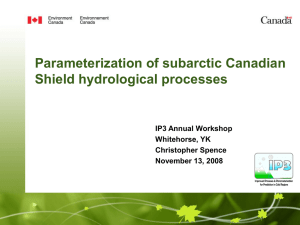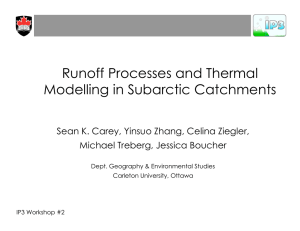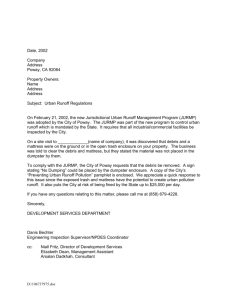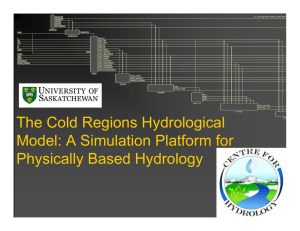Th ht P t i ti
advertisement
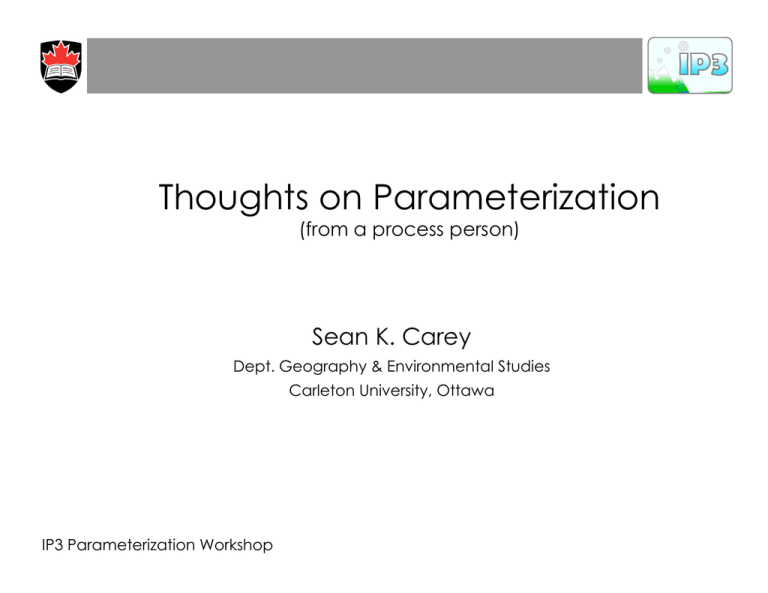
Th Thoughts ht on Parameterization P t i ti (from a process person) Sean K K. Carey Dept. Geography & Environmental Studies Carleton University, Ottawa IP3 Parameterization Workshop The Context Massive amounts of observation data Difficult to synthesize At smaller scales, we have processes that are apparently common, yet at larger scales, we have “catchment functioning” which, certainly in the literature, presents every catchment as a unique situation. situation The Context It is difficult to extrapolate what we observe at the plot/slope scale to larger scales – even the HRU scale – as most of our process knowledge is “control volume” based, and larger scale theories are often overtly complex and/or just theories. theories We have never “proven” proven HRUs exist – they just do for our convenience. Perspectives on parameterization Don’t reinvent the wheel. Perspectives on parameterization Be cognizant of the data. In most cases, there is little or no data (or reanalysis data) This should be considered when developing parameterization schemes – or at least testing th them. Why Wh would ld we make k our parameterization t i ti schemes reliant on massive amounts of data? However However….. We should base them on massive amounts of data and direct observation. Parameterization in IP3 Basin-scale controls on runoff: – Thaw – Infiltration/redistribution in organic soils – Runoff Don’t start parameterizing until we know that we know what we know….. An example – ground thaw Objectives: – Evaluate the performance of commonly used simulation algorithms in permafrost regions – Evaluate commonly used soil parameterization schemes for both mineral and organic soil – Provide guidelines for the implementation of appropriate ground thermal models Simulation Algorithms SemiSemi empirical Z = β F 0.5 Accumulated Temperature Index Algorithm (ATIA) Two Directional Stefan Algorithm (TDSA) Z = [2 KF /( ρLθ )]0.5 Analytical Hayashi’s Modification to Stefan Algorithm (HMSA) Z =[2/(ρLθ)] [86400∑(KbTs )] Finite Difference Thermal Conduction M th d with Method ith DECP (FD_DECP) (FD DECP) Numerical Finite Difference Thermal Conduction Method with AHCP (FD_AHCP) (FD AHCP) Finite Element Thermal Conduction Method with AHCP (FE_TONE) (FE TONE) 0.5 0.5 Latent Heat Parameterisation DECP: Decoupled Energy Conservation Parameterisation AHCP: Apparent AHCP A t Heat H t Capacity Parameterisation Parameter tests Tests of soil thermal conductivity parameterisation --Johansen’formulation --De D V Vries’s i ’ fformulation l ti Test of unfrozen water parameterisation --Segmented g linear functions --Power function --Water potential-freezing point depression formulation Tests of simulation algorithms (best parameterisation) --Run1: All the available inputs (Ttop, Tbot, θw, θice,Ts,ini) --Run2: Without Tbot, lower boundary conditions and θw, θice,TTs,ini have to be assumed. assumed --Run3: Only Ttop was supplied. Soil water assumed to be saturated at all times. Model Results 0.0 (a) -0.2 (b) D eppth(m ) Dep pth(m) 0.0 -0.4 -0.6 -0.8 0.0 SC SC 0 20 40 60 0 50 100 150 200 (d) GC 20 40 60 0 20 40 60 (f) D eepth(m ) (e) WC_NFS 20 WC_NFS 40 60 80 0 50 100 150 (g) 200 (h) D epth(m ) De epth(m) De epth(m) 0 0 WC_SFS 0 SC SC 0 20 40 60 0 50 100 150 200 (d) -0.1 -0.2 -0.3 GC GC -0.4 -0.4 0.0 -0.2 -0.4 -0.6 -0.8 -1.0 10 -1.2 -1.4 -0.6 (c) -0.2 0.0 -0.2 -0.4 -0.6 -0.8 -1.0 -1.2 -1.4 -0.4 0.0 D e pth(m ) Dep pth(m) (c) GC (b) -0.8 -0.1 -0.3 (a) -0.2 20 WC_SFS 40 60 80 Days after observed thawing-start 0 50 100 150 200 Days after observed freezing-start Tests of different soil thermal conductivity parameterisation methods, i.e. Complete Johansen Johansen’ss equations (dark solid lines), Commonly used Johansen’s equations (grey solid lines), and a simplified de Vries’s method (dashed lines). Open circles are observations. 0.0 -0.2 -0.4 -0.6 -0.8 -1.0 10 -1.2 -1.4 0.0 -0.2 -0.4 -0.6 -0.8 -11.00 -1.2 -1.4 0 20 40 60 0 20 40 60 (f) (e) WC_NFS WC_NFS 0 20 40 60 80 0 50 100 150 (g) WC_SFS 0 20 200 (h) WC_SFS 40 60 80 Days after observed thawing-start 0 50 100 150 200 Days after observed freezing-start Test of unfrozen water parameterisation methods, i.e. segmented linear function (dark solid lines) lines), power function ( grey solid lines) and water potential-freezing point depression Model Results 0.0 0.0 (b) (a) -0.2 -0.4 -0.2 -0.6 HMSA ATIA -0.3 -0.8 0.0 (d) (c) -0.2 -0.4 -0.6 FD_DECP TDSA -0.8 0.0 -0.2 -0.3 TDSA FD_DECP ((f)) (e) (f) (e) -0.1 -0.4 (d) (c) -0.1 -0.4 0.0 02 -0.2 HMSA ATIA -0.4 00 0.0 Depth (m) Depth (m) (b) (a) -0.1 -0.2 -0.6 FD_AHCP TONE -0.8 -0.3 -0.4 0 40 80 120 160 200 240 280 320 360 0 40 80 120 160 200 240 280 320 360 Days after September 1 1, 2004 Comparisons of observed (symbols) and simulated (lines) thawing (dark circles for observation) and freezing (grey circles for observation) depths at Scotty Greek with six g and three sets of model runs, i.e., Run1 ((dark algorithms solid lines), Run2 (dark dashed lines) and Run3 (grey solid lines). TONE FD_AHCP 0 40 80 120 160 200 240 280 0 40 80 120 160 200 240 280 Days after April 23, 2002 Comparisons of observed (symbols) and simulated (lines) thawing (dark circles for observation) and freezing (grey circles for observation) depths at Granger Greek with six algorithms and three sets of model runs, i.e., Run1 (dark solid lines), Run2 (dark dashed lines) and Run3 (grey solid lines). Infiltration into frozen soils – New Field Experiments – New Instrumentation (MFHPP) – New Modelling Modify Hydrus 1-D SHAW HAWTS SHAW – 2004 Scotty Creek SHAW – 2005 Scott Creek Detailed heat/water simulations Heat Water Devries Lf ⎛ T ⎜ ψ = g ⎜⎝ Tk ⎛θ ⎞ cRT k ⎟⎟ + = ψ e ⎜⎜ l g ⎝ θ0 ⎠ ⎞ ⎟⎟ ⎠ −b Clapp-Hornberger Infiltration Paramterization…….? Not yet….. Runoff While it may seems straight-forward, modelling runoff (we’ve been doing it for decades), at the HRU scale it is i challenging. h ll i “Emergence” is a term rapidly polluting itself in the runoff community. community Do our plot/field scale results have any relevance at g scale? the HRU or larger Runoff Some debating points: – Should we base parameterization on conservation equations at the point scale? – How do we scale other linked properties like momentum? Or do we even need to? – Environmental mechanics typically yp y use some sort of gradient/potential approach – is this appropriate at larger scales? Field-scale Ksat increases an order of magnitude for every magnitude of scale increase. Runoff Landscape L d Geometry G t – Travel/Residence time based on terrain geometry and soil attributes. tt ib t – Advantages: relatively easy extraction from DEM/Satellites – Drawbacks: Do we really know that each HRU is an HRU? What field evidence do we even have that HRUs exist? Start Is HRU/tile at the outlet above capacity? Note cumulative storage from t-1 time step yes no Input forcing data Calcaulte sub-grid runoff with cdf slope distribution function Grid runoff = 0 Run vertical water budget; Distribute sub-grid runoff with cdf slope distribution function Route runoff from grid Calculate change in storage for each tile/HRU End Recalculate HRU/tile water budget Calculate cumulative storage for each tile/HRU 35 2 y = -864.33x + 1596.4x - 699.22 30 Do any tiles/HRU’s have a positive S-St value? yes Flag HRU’s/tiles HRU s/tiles with positive S-St values 25 R unoff no 40 Note storage minus storage threshold; this is water available for runoff runoff distribution function 20 15 10 5 output each HRU/tile’s distance to stream outlet, area, S-St flags to table Calculate pdf and slope of cdf of storage capacity exceedance vs distance from outlet of HRU/tile’sthat have exceeded storage capacity 0 0.8 0.85 0.9 0.95 1 slope of Sc - distance cdf Parameter file for each tile/HRU includes: 1) Storage threshold 2) Distance from outlet 3) Area 4) Runoff distribution function 1.05 Landscape Classification LB SF UB TS3 SS2 SS1 TS2 TS1 SS1 Gauge 500 m More classification Runoff Tracers – We still have not fully utilized tracers in our work. work Residence Time Distribution determinations are becoming increasingly common in the literature, literature yet not used here. This may be the best way to physically-stochastically parameterize runoff at larger scales. – Can tracer-based RTD be linked to basin-scale attributes? It can in other environments, but in IP3 basins, we have a unique set of problems. Runoff The key to parameterization (I think) is capturing these emergent properties at the HRU scale not observed b d att the th slope/plot l / l t scale. l While Whil we often ft model HRU scale variables (like mean thaw depth with the appropriate moments) – how do these moments act to affect infiltration/runoff, etc?
